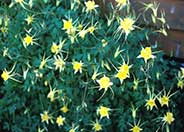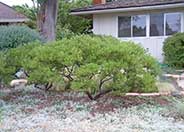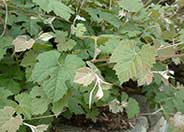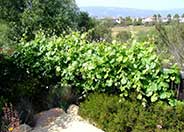
Common name:Purple Leaf Eastern Redbud
Botanical name:Cercis canadensis 'Forest Pansy'
This small tree may reach 25' tall and it has dark green/purple leaves that are purple in the fall. Amazing pink flowers bloom in the spring and fill the tree.

Common name:Columbine
Botanical name:Aquilegia hybrids
Coumbine has large, spurred flowers with clear colors of white, lavender, yellow, deep red and pink which are borne on 2 1/2' tall plants. The strikingly beautiful blooms make good cut flowers. They require partial shade or full sun, along with well- drained soil. The colors, however, cannot be chosen.

Common name:Howard McMinn Manzanita
Botanical name:Arctostaphylos densiflora 'Howard McMinn
This shrub is highly appreciated for its decorative characteristics, which include a dense show of small, pale pink urn-shaped flowers. Above all, it is the mahogany-red to brown bark (which peels beautifully) that is the major attraction. Its fruit resembles the tike apple, and the flowers contrast perfectly to the light green leaf (which can get rather tough). It blooms from late winter to spring.
Maintenance Tips
Arctostaphylos densiflora 'Howard McMinn’ is one of the most popular hybrids of the California native Manzanita. It matures at 7-10' tall and wide with a dense branching structure. The branches have a smooth, dark red bark that is one of the favored characteristics of this plant. It is slow growing and very low maintenance; however, many gardeners do not allow the space they need to reach their mature size. Plant in full sun to part shade in well-drained soil. As it matures, move other plants away if it is getting crowded. Pruning will only be needed to shape the plant or to remove any cross branches. They are susceptible to root rot, which usually occurs in the hottest month when there is a tendency to overwater. Watering deep and infrequently during the cooler months is essential to the health of this plant. Allow the soil to dry out in the summer.
Common name:California Wild Grape
Botanical name:Vitis californica
The California Wild Grape is a woody deciduous vine that with round large leaves. The flowers are in small fragrant blooms and berry clusters appear in the summer. This vine has a sprawling, climbing growth habit. The California wild Grape is native to California and is drought tolerant.

Common name:California Gray Rush
Botanical name:Juncus patens
Although a wetland plant, Juncus patens can tolerate fairly dry conditions. It will slowly clump to 2'-3' wide and a height of 2'-2.5'. There are many selections of this species available with different heights and widths. It is carefree, with little to no maintenance. It provides great upright structure to many styles of landscapes.

Common name:European Grapevine
Botanical name:Vitis vinifera
This vine grows 20'-30' long. Many species of this vine produce today's wines and grapes. There are thousands of species worldwide, but this plant originated in Europe. Vitis is a woody perennial that climbs its way around the supports. It does better with long, warm to hot summers, with mild winters. Frost will kill the young shoots. Vitis does not do well with humidity, as it promotes disease. Well-drained soil is important also.

Common name:California Fescue
Botanical name:Festuca californica
The California Fescue is a cool season bunchgrass with blue green blades that reach 2'-5' high and 3' wide. Foliage arches gracefully upwards and outwards. Flower spikes reach 3' above the leaves. Plant in full sun or partial shade. It makes a great companion plant to oak trees and is handsome as a backdrop behind lower growing grasses for a meadow look. The California fescue is native to California and is a beneficial insect plant.
Designer: Owen Dell
Photographer: GardenSoft
Maintain a two to four inch layer of mulch on the soil surface to reduce weeds, infiltrate rain water, and reduce compaction.
Drip and other smart irrigation delivers water directly to roots, allowing no excess water for weeds.